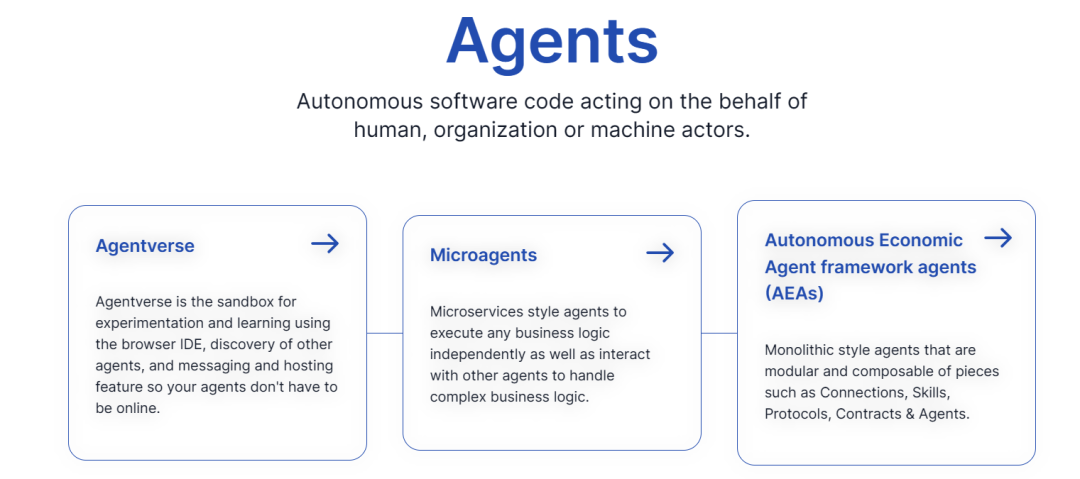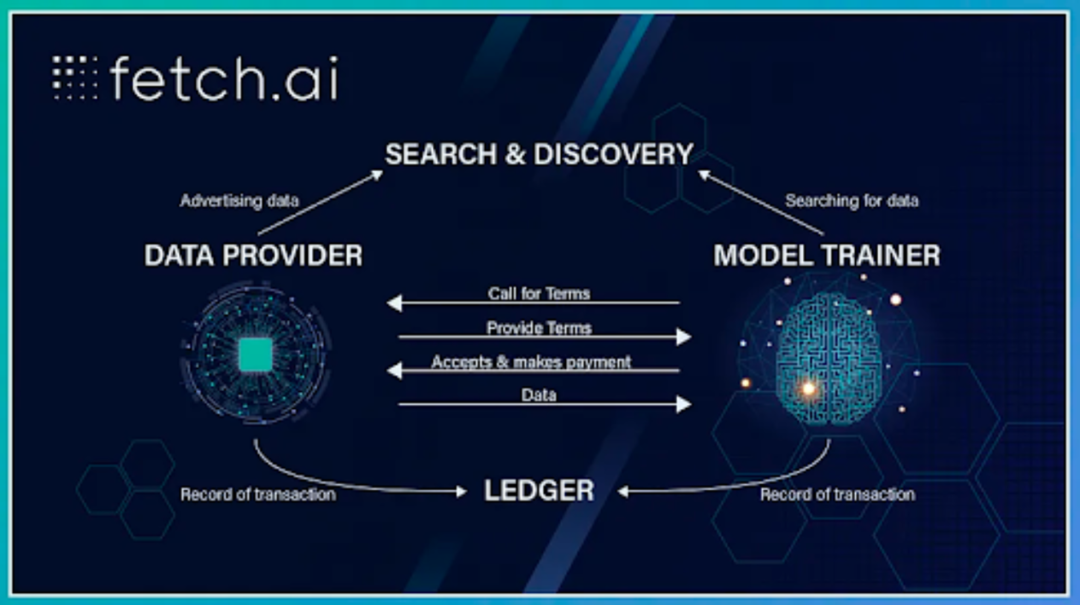As a technology company that deeply combines blockchain and artificial intelligence technology, Fetch.AI aims to build a decentralized smart economy and achieve distributed goals by combining artificial intelligence, blockchain and Internet of Things technologies . The company's goal is to provide businesses and consumers with an entirely new way to interact economically, enabling more efficient, secure and smarter transactions.
Thanks to the highly intelligent and open architecture of the AI+ blockchain, Fetch.AI has a wide range of application scenarios, including logistics, supply chain, finance, energy, medical care and other fields. The technical architecture of Fetch.AI mainly includes two parts: Fetch.AI main chain and Fetch.AI intelligent agent. The Fetch.AI main chain is a distributed ledger based on blockchain technology, which is used to record transactions and smart contracts, and ensure the security and reliability of transactions. The Fetch.AI smart agent is a smart contract with artificial intelligence capabilities that can autonomously perform tasks, coordinate resources, and interact with other smart agents to achieve automated, intelligent, and decentralized economic interactions.
first level title
Let network nodes manage themselves: Autonomous Economic Agent Architecture (AEA)
On the Fetch.ai network, individuals or companies with data are represented by their agents, who contact the agents of individuals or companies seeking data. The agency operates on the Open Economic Framework (OEF). This acts as a search and discovery mechanism where agents representing data sources can advertise the data they have access to. Likewise, individuals or companies looking for data can use OEF to search for agents with access to the data in question.

Fetch.AI's AEA architecture is a distributed intelligent agent architecture for building autonomous and collaborative intelligent agent networks. AEA stands for Autonomous Economic Agent,Its core idea is to combine artificial intelligence and blockchain technology to build a decentralized smart economy and realize intelligent, autonomous and decentralized economic interaction.
The core components of the AEA architecture mainly include the following four modules:
AEA Agent (Agent):An AEA agent is an autonomous, programmable intelligent agent with the capabilities of autonomous decision-making, autonomous collaboration, and autonomous learning. It is the core component of AEA and represents an independent entity with the capability of autonomous decision-making and action. Each AEA agent has its own wallet address, identity and smart contract, and can interact and cooperate with other agents.
AEA Communication (Connection):AEA communication is a point-to-point communication protocol based on blockchain technology, which is used to realize information transmission and interaction between agents. AEA communication can ensure the security and reliability of the interaction. Fetch.AI's AEA supports multiple connection methods, including WebSocket and HTTP connections.
AEA skills (Skill):An AEA skill is a pluggable module used to extend the functionality and capabilities of an AEA agent. Each skill consists of a smart contract and a Python package for implementing specific functionality of the agent, such as natural language processing, machine learning, decision making, etc. Skills can contain multiple protocols and models so that agents can understand and respond to requests from other agents.
AEA protocol (Protocol):The AEA protocol is a cooperation mechanism for the cooperation and interaction between agents. The AEA protocol defines the message format, protocol flow and interaction rules between agents, so as to realize the collaborative work between agents. Protocols are the rules and guidelines for communication between agents. Protocols define how agents should exchange information, respond to requests, and handle errors. Fetch.AI's AEA supports multiple protocols, including Fetch.AI's own Agent Communication Language (ACL) and the HTTP protocol.
Imagine a company is looking for data to train a predictive model. When a company's agent connects to an agent representing a data source, it will ask it for information about trade terms. An agent working on behalf of the data provider will then offer the terms on which it is willing to sell the data. An agent selling access to data may seek the highest possible price, while an agent buying access to data wants to pay the lowest possible price. But the agency selling the data knows that if it charges too much, it will miss out on the deal. This is because proxies seeking data will not accept the terms and will instead attempt to purchase data from another source on the web. If the buying agent does find the terms acceptable, then it will pay the sales agent the agreed price via a transaction on the Fetch.ai ledger. After receiving payment, the agent selling the data will send the encrypted data through the Fetch.ai network.
first level title
The core of making nodes intelligent: AEA skill module and group learning (Colearn) mechanism
Among the above four modules, the most important one is the AEA skill module, which is the key module for making nodes intelligent. AEA skill is a pluggable module for realizing group self-learning function of agents. Each learning skill includes a smart contract and a Python package for implementing different types of learning tasks, such as reinforcement learning, supervised learning, unsupervised learning, etc. When an agent needs to learn, it can choose the learning skills suitable for itself and save the learning results in its own state. Agents can autonomously adjust behaviors and strategies based on learning results, enabling smarter, more efficient and more sustainable economic interactions.

The collective learning principle of Fetch.AI consists of the following steps:
data sharing:Different agents collect their own data and upload it to a shared database in the blockchain network. These data can be sensor data, text data, image data, etc. All agents participating in collective learning can access the data in the shared database and use these data for training.
Model training:Agents use data from a shared database for model training. Models can be machine learning models, deep learning models, or other types of algorithms. Agents can be trained using different models in order to learn different tasks or problems.
Model selection:After the model training is complete, the agent uploads its model to the blockchain network. All agents participating in collective learning can access these models and choose the one that suits them according to their needs. The selection process can be based on factors such as agent performance, task requirements, and resource constraints.
Model integration:bonus system:
bonus system:In the process of collective learning, agents can get rewards by contributing their own data and models. Rewards can be allocated based on factors such as agent performance, contribution, and resource utilization efficiency. Reward mechanisms can encourage agents to actively participate in collective learning and improve overall system performance.
Suppose there are two agents, A and B, who need to cooperate to complete a task, such as transporting goods.Agent A is responsible for delivering the goods and Agent B is responsible for providing the transportation service. In the initial interaction, both agent A and agent B can adopt a random behavior strategy to complete the task, such as randomly choosing a transportation route or transportation method.
As the interaction progresses, agent A and agent B can learn interaction history data by learning skills, and adjust behavior strategies autonomously according to the learning results. For example, agent A can learn information such as the supply of goods and transportation costs through learning skills, so as to independently choose the optimal cooperation strategy according to the current demand for goods and market prices. Agent B can also learn information such as the efficiency and cost of transportation routes and transportation methods through learning skills, so as to independently choose the optimal transportation strategy according to the current traffic conditions and energy prices.
As the interaction continues and the learning results are continuously updated, Agent A and Agent B can gradually optimize their own behavior strategies to achieve more efficient, smarter and more sustainable economic interactions. This self-learning process can be continuously iterated and optimized to achieve better economic benefits and social value.
It should be noted that the self-learning function requires the agent to have sufficient computing power and data resources in order to achieve a good learning effect. Therefore, in practical applications, it is necessary to select the appropriate learning skills and resource allocation according to the actual situation and needs of the agent, so as to achieve the best learning effect.
Fetch.ai's core autonomous economic agent (AEA) achieves the goals of intelligence, autonomy and decentralization in terms of economic interaction. Its advantage lies in the deep integration of artificial intelligence and blockchain technology, and the realization of the design of autonomous economic agents. These AEA agents can learn independently, make decisions and interact freely in a decentralized environment, improving the efficiency and efficiency of economic interaction. The degree of intelligence. In addition, Fetch.AI's Collearn mechanism encourages active participation of agents to improve the performance of the entire system by sharing data and models.
first level title
Summary
Disclaimer: This article is for research information only and does not constitute any investment advice or recommendation. The project mechanism introduced in this article only represents the author's personal opinion, and has no interest in the author of this article or this platform. Blockchain and digital currency investments are subject to various uncertainties such as extremely high market risk, policy risk, and technical risk. The price of tokens in the secondary market fluctuates violently. Investors should make cautious decisions and independently bear investment risks. The author of this article or this platform is not responsible for any losses caused by investors using the information provided in this article.
references:
[ 1 ] Fetch.AI Developer Documentation
[ 2 ] Melanie Mitchell: AI 3.0
[ 3 ] Alexey Potapov: Basic Atomese Features required
Disclaimer: This article is for research information only and does not constitute any investment advice or recommendation. The project mechanism introduced in this article only represents the author's personal opinion, and has no interest in the author of this article or this platform. Blockchain and digital currency investments are subject to various uncertainties such as extremely high market risk, policy risk, and technical risk. The price of tokens in the secondary market fluctuates violently. Investors should make cautious decisions and independently bear investment risks. The author of this article or this platform is not responsible for any losses caused by investors using the information provided in this article.